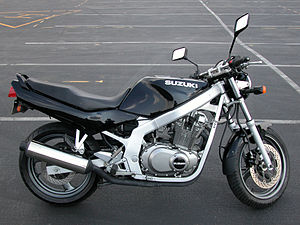Suzuki GS 500 E.
| Suzuki | |
|---|---|
 1997 Suzuki GS 500 E. |
|
| Suzuki GS 500 E / F | |
| Manufacturer | Suzuki Motor Corporation |
| Production period | 1989 to 2007 |
| class | motorcycle |
| design type | Naked bike |
| Motor data | |
| air-cooled two-cylinder four-stroke in-line engine, DOHC , 2 valves per cylinder, 2 constant pressure carburetors | |
| Displacement (cm³) | 487 |
| Power (kW / PS ) | 34/46 |
| Torque ( N m ) | 40 Nm (3.9 kpm) at 7,900 rpm |
| transmission | 6 courses |
| drive | Chain |
| Brakes | Front disc brake, Ø 310 mm, double-piston caliper, rear disc brake, Ø 250 mm, double-piston caliper |
| Wheelbase (mm) | 1,410 |
| Dimensions (L × W × H, mm): | 2180 × 755 × 1045 |
| Seat height (cm) | 79 |
| Empty weight (kg) | 174 (dry) |
| Previous model | GS 400 |
The Suzuki GS 500 is a motorcycle from the Japanese manufacturer Suzuki , which has been built since 1989 with various technical changes. The motorcycle is now available in the variants GS 500 ( naked bike ) and GS 500 F with fairing. The engine of today's GS 500 E is derived from the GS 400 of the late 1970s and early 1980s, which was built into the GSX 400 E from 1984 . From 1978 to 1981 there was a GS 550 E with a 50 hp four-cylinder engine, which belonged to the series of the GS 550/750 (with chain drive) and GS 850/1100 (with cardan drive).
The GS 500 is a popular entry-level and driving school motorcycle in Germany because of its uncomplicated driving characteristics, the manageable range of services and the comparatively low maintenance costs.
Because of the strict emissions regulations, the GS 500 E / F has not been sold in Germany since 2006. In some other countries, however, you can still buy them today.
Technical data (as of 03/2008)
engine
- An air-cooled two-cylinder four-stroke in-line engine , a balancer shaft , two overhead chain-driven camshaft ( DOHC ), tappets , 2 valves per cylinder wet sump lubrication, two Ø 33 mm Mikuni BSR constant pressure carburetor , electronic transistor coil ignition, exhaust gas purification: from MY 2004 PAIR Secondary air system and uncontrolled catalytic converter , electric starter, three-phase alternator 200 watts, battery 12 V / 11 Ah.
- Bore × stroke 74 × 56.6 mm
- Cubic capacity 487 cm³
- Compression ratio 9.0: 1
- Rated output : 25 kW / 34 PS at 8,500 / min (from importer or throttling for driving license class A2 (old. A limited)), open 35 kW / 47 PS at 9,200 / min after conversion at the dealer (33 to 34 kW / 45 to 46 HP in earlier years of construction)
- Max. Torque : 34 Nm at 4,600 rpm (open: 40 Nm at 7,900 rpm)
- Power transmission: primary drive via gear wheels, mechanically operated multi-disc oil bath clutch, six-speed gearbox, O-ring chain .
landing gear
- Double loop frame made of square steel profiles
- Telescopic fork , stanchion diameter 37 mm, 120 mm travel
- Two-arm swing arm made of steel profiles, central spring strut articulated via a lever system with 7-way adjustable spring base, 115 mm spring travel
- Front disc brake , Ø 310 mm, double-piston floating caliper
- Rear disc brake, Ø 250 mm, double piston fixed
saddle
- Tire size front 110/70 H 17 on 3.00 × 17 "alloy wheel
- Rear tire size 130/70 H 17 on 3.50 × 17 "alloy wheel
mass and weight
- Wheelbase 1405 mm
- Steering head angle 64.5 °
- Trail 95 mm
- Seat height 790 mm
- Tank capacity GS 500 E: 17 l; GS 500 F: 20 l (of which 3.5 l reserve)
- Dry weight 174 kg
- Empty weight 188 kg
- permissible total weight 380 kg.
Performance
Measured values from MOTORRAD 19/2000
- Top speed solo (with pillion passenger) 162 (152) km / h
- Acceleration solo (with pillion passenger) 0–100 km / h 5.4 (6.9) sec
- Elasticity / pulling solo (with pillion passenger) 60–140 km / h 17.4 (25.6) sec
- Consumption Ø 4.6 l / 100 km, regular petrol (91 RON), this results in a range of approx. 400 km for the F-model and approx. 350 km for the E-model.


